Report on Strategies and Challenges: 21st Century Learning Environment
VerifiedAdded on 2022/01/04
|9
|1817
|44
Report
AI Summary
This report provides a comprehensive overview of the 21st Century Learning Environment, examining its current state, challenges, and future possibilities. It begins with an executive summary and an introduction highlighting the evolving role of education. The report then delves into strategies for strengthening the impact of teaching, such as Universal Design for Learning (UDL), and explores challenging strategies including feedback mechanisms, metacognition, collaborative inquiry, and flipped classrooms. The discussion includes critical analyses of research articles, identifying the challenges in implementing new educational strategies. Finally, the report envisions the future of the 21st Century Learning Environment, emphasizing the importance of 21st-century skills and the interconnectedness of global systems. The study concludes by analyzing the need for strategic implementation of educational concepts to avoid confusion and criticism, envisioning the future possibilities of education.
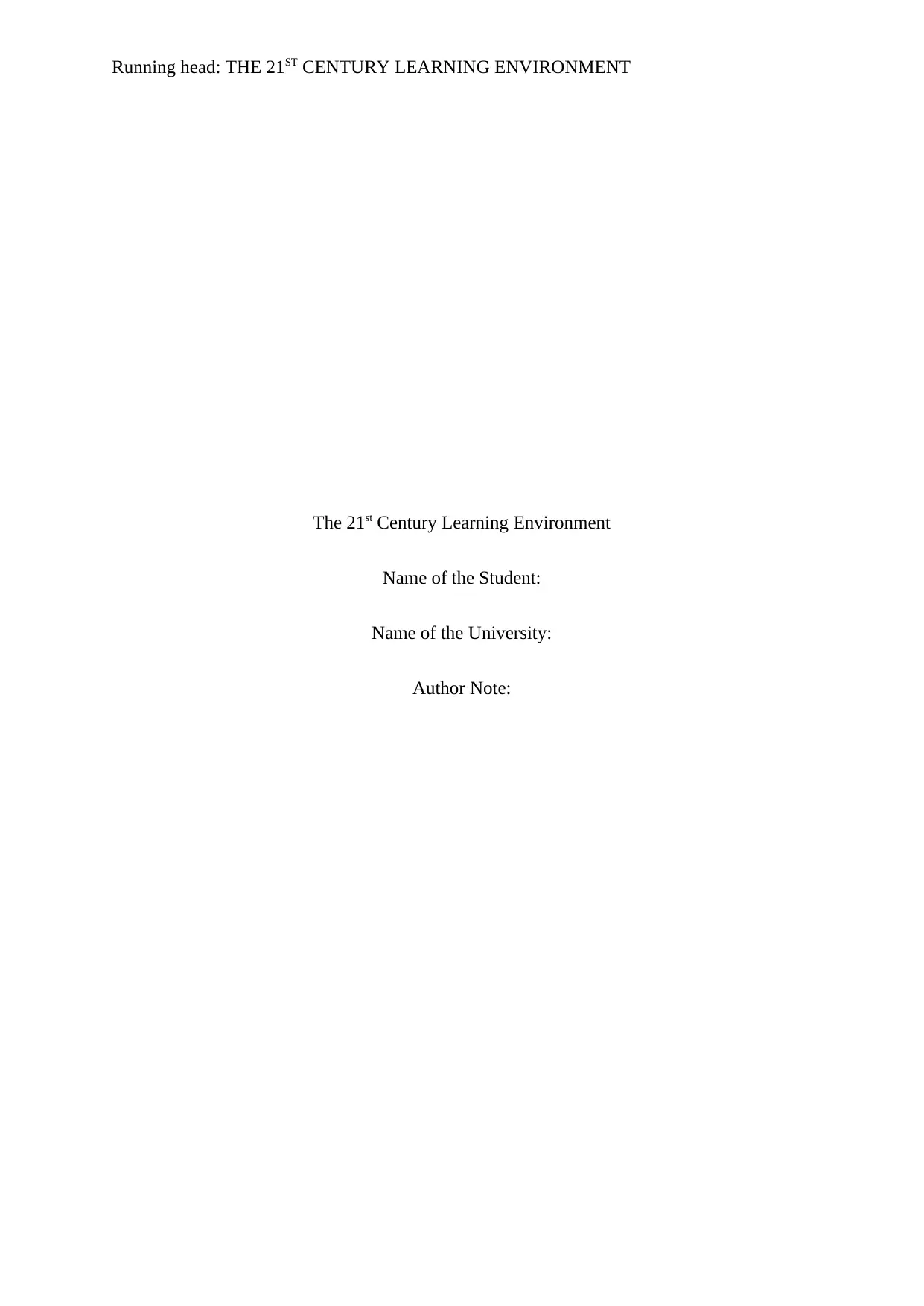
Running head: THE 21ST CENTURY LEARNING ENVIRONMENT
The 21st Century Learning Environment
Name of the Student:
Name of the University:
Author Note:
The 21st Century Learning Environment
Name of the Student:
Name of the University:
Author Note:
Paraphrase This Document
Need a fresh take? Get an instant paraphrase of this document with our AI Paraphraser
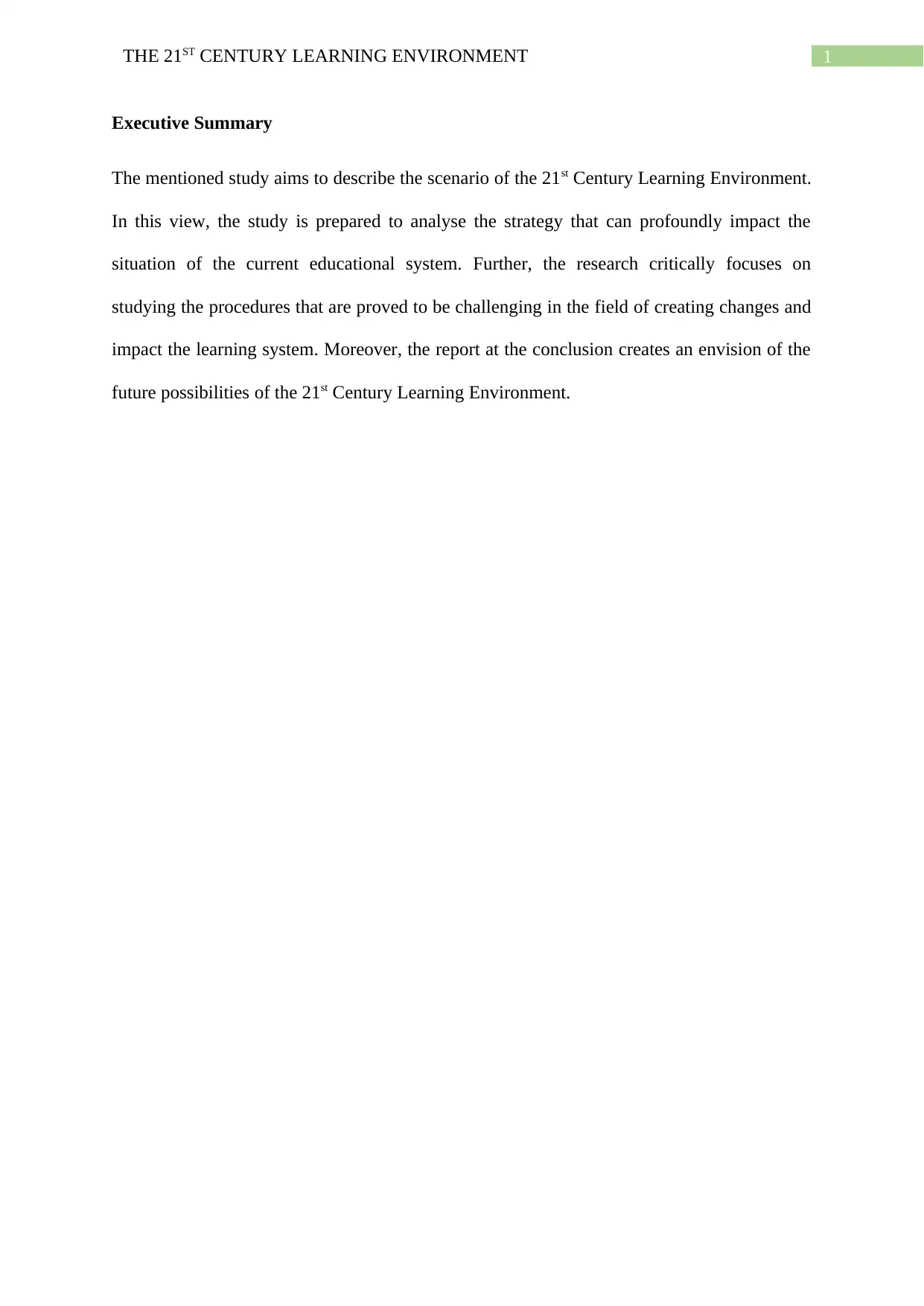
1THE 21ST CENTURY LEARNING ENVIRONMENT
Executive Summary
The mentioned study aims to describe the scenario of the 21st Century Learning Environment.
In this view, the study is prepared to analyse the strategy that can profoundly impact the
situation of the current educational system. Further, the research critically focuses on
studying the procedures that are proved to be challenging in the field of creating changes and
impact the learning system. Moreover, the report at the conclusion creates an envision of the
future possibilities of the 21st Century Learning Environment.
Executive Summary
The mentioned study aims to describe the scenario of the 21st Century Learning Environment.
In this view, the study is prepared to analyse the strategy that can profoundly impact the
situation of the current educational system. Further, the research critically focuses on
studying the procedures that are proved to be challenging in the field of creating changes and
impact the learning system. Moreover, the report at the conclusion creates an envision of the
future possibilities of the 21st Century Learning Environment.
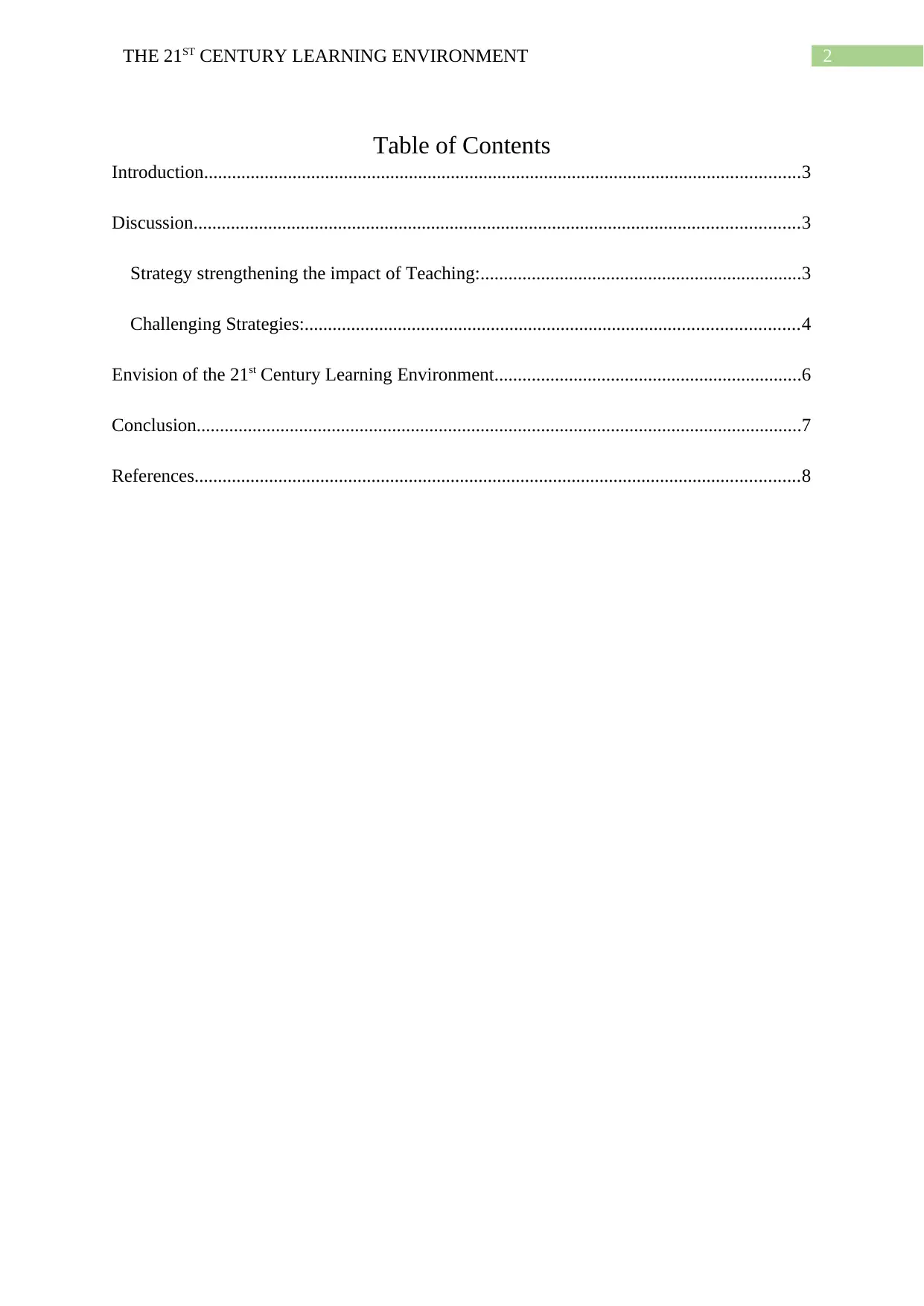
2THE 21ST CENTURY LEARNING ENVIRONMENT
Table of Contents
Introduction................................................................................................................................3
Discussion..................................................................................................................................3
Strategy strengthening the impact of Teaching:.....................................................................3
Challenging Strategies:..........................................................................................................4
Envision of the 21st Century Learning Environment..................................................................6
Conclusion..................................................................................................................................7
References..................................................................................................................................8
Table of Contents
Introduction................................................................................................................................3
Discussion..................................................................................................................................3
Strategy strengthening the impact of Teaching:.....................................................................3
Challenging Strategies:..........................................................................................................4
Envision of the 21st Century Learning Environment..................................................................6
Conclusion..................................................................................................................................7
References..................................................................................................................................8
⊘ This is a preview!⊘
Do you want full access?
Subscribe today to unlock all pages.

Trusted by 1+ million students worldwide
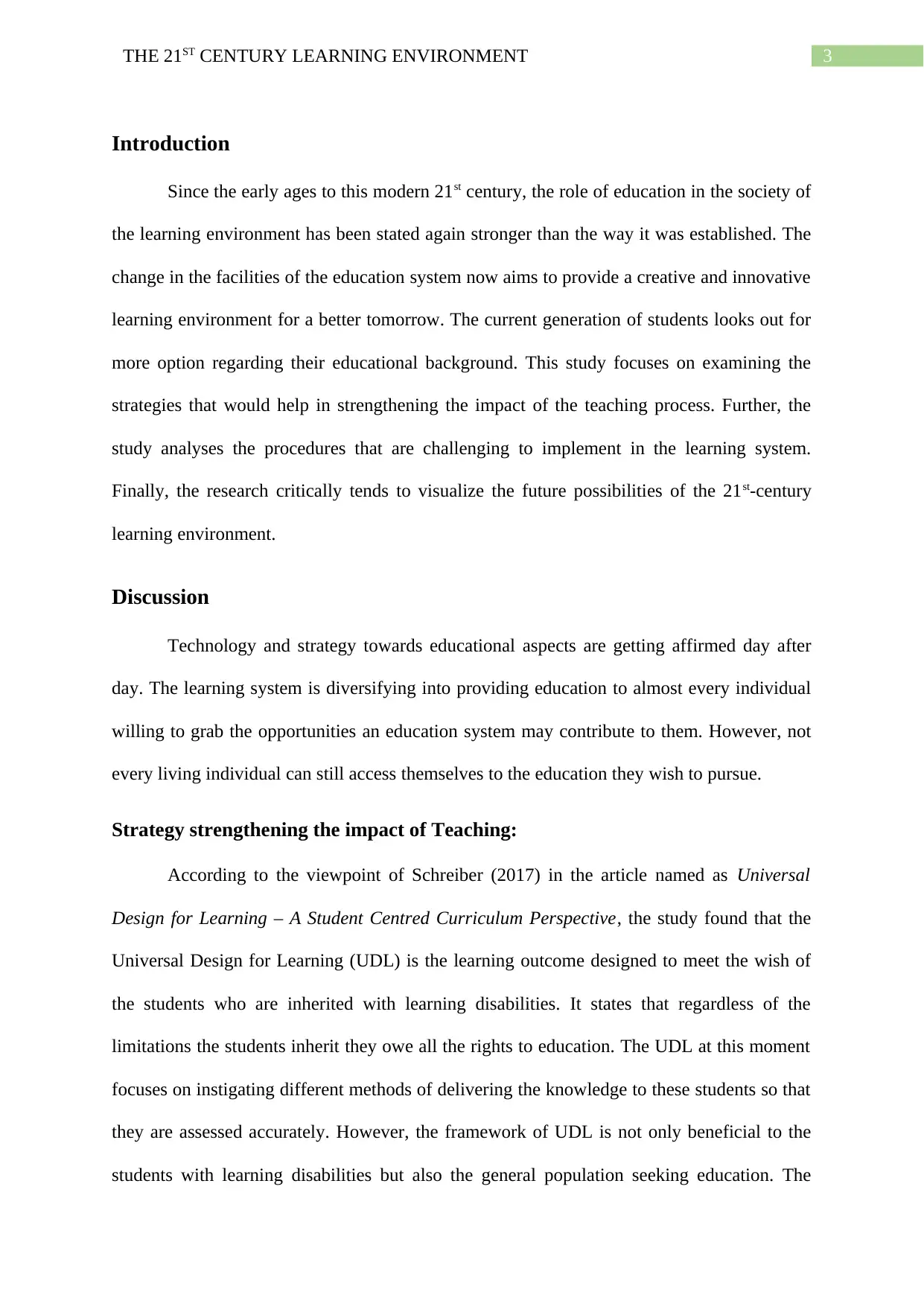
3THE 21ST CENTURY LEARNING ENVIRONMENT
Introduction
Since the early ages to this modern 21st century, the role of education in the society of
the learning environment has been stated again stronger than the way it was established. The
change in the facilities of the education system now aims to provide a creative and innovative
learning environment for a better tomorrow. The current generation of students looks out for
more option regarding their educational background. This study focuses on examining the
strategies that would help in strengthening the impact of the teaching process. Further, the
study analyses the procedures that are challenging to implement in the learning system.
Finally, the research critically tends to visualize the future possibilities of the 21st-century
learning environment.
Discussion
Technology and strategy towards educational aspects are getting affirmed day after
day. The learning system is diversifying into providing education to almost every individual
willing to grab the opportunities an education system may contribute to them. However, not
every living individual can still access themselves to the education they wish to pursue.
Strategy strengthening the impact of Teaching:
According to the viewpoint of Schreiber (2017) in the article named as Universal
Design for Learning – A Student Centred Curriculum Perspective, the study found that the
Universal Design for Learning (UDL) is the learning outcome designed to meet the wish of
the students who are inherited with learning disabilities. It states that regardless of the
limitations the students inherit they owe all the rights to education. The UDL at this moment
focuses on instigating different methods of delivering the knowledge to these students so that
they are assessed accurately. However, the framework of UDL is not only beneficial to the
students with learning disabilities but also the general population seeking education. The
Introduction
Since the early ages to this modern 21st century, the role of education in the society of
the learning environment has been stated again stronger than the way it was established. The
change in the facilities of the education system now aims to provide a creative and innovative
learning environment for a better tomorrow. The current generation of students looks out for
more option regarding their educational background. This study focuses on examining the
strategies that would help in strengthening the impact of the teaching process. Further, the
study analyses the procedures that are challenging to implement in the learning system.
Finally, the research critically tends to visualize the future possibilities of the 21st-century
learning environment.
Discussion
Technology and strategy towards educational aspects are getting affirmed day after
day. The learning system is diversifying into providing education to almost every individual
willing to grab the opportunities an education system may contribute to them. However, not
every living individual can still access themselves to the education they wish to pursue.
Strategy strengthening the impact of Teaching:
According to the viewpoint of Schreiber (2017) in the article named as Universal
Design for Learning – A Student Centred Curriculum Perspective, the study found that the
Universal Design for Learning (UDL) is the learning outcome designed to meet the wish of
the students who are inherited with learning disabilities. It states that regardless of the
limitations the students inherit they owe all the rights to education. The UDL at this moment
focuses on instigating different methods of delivering the knowledge to these students so that
they are assessed accurately. However, the framework of UDL is not only beneficial to the
students with learning disabilities but also the general population seeking education. The
Paraphrase This Document
Need a fresh take? Get an instant paraphrase of this document with our AI Paraphraser
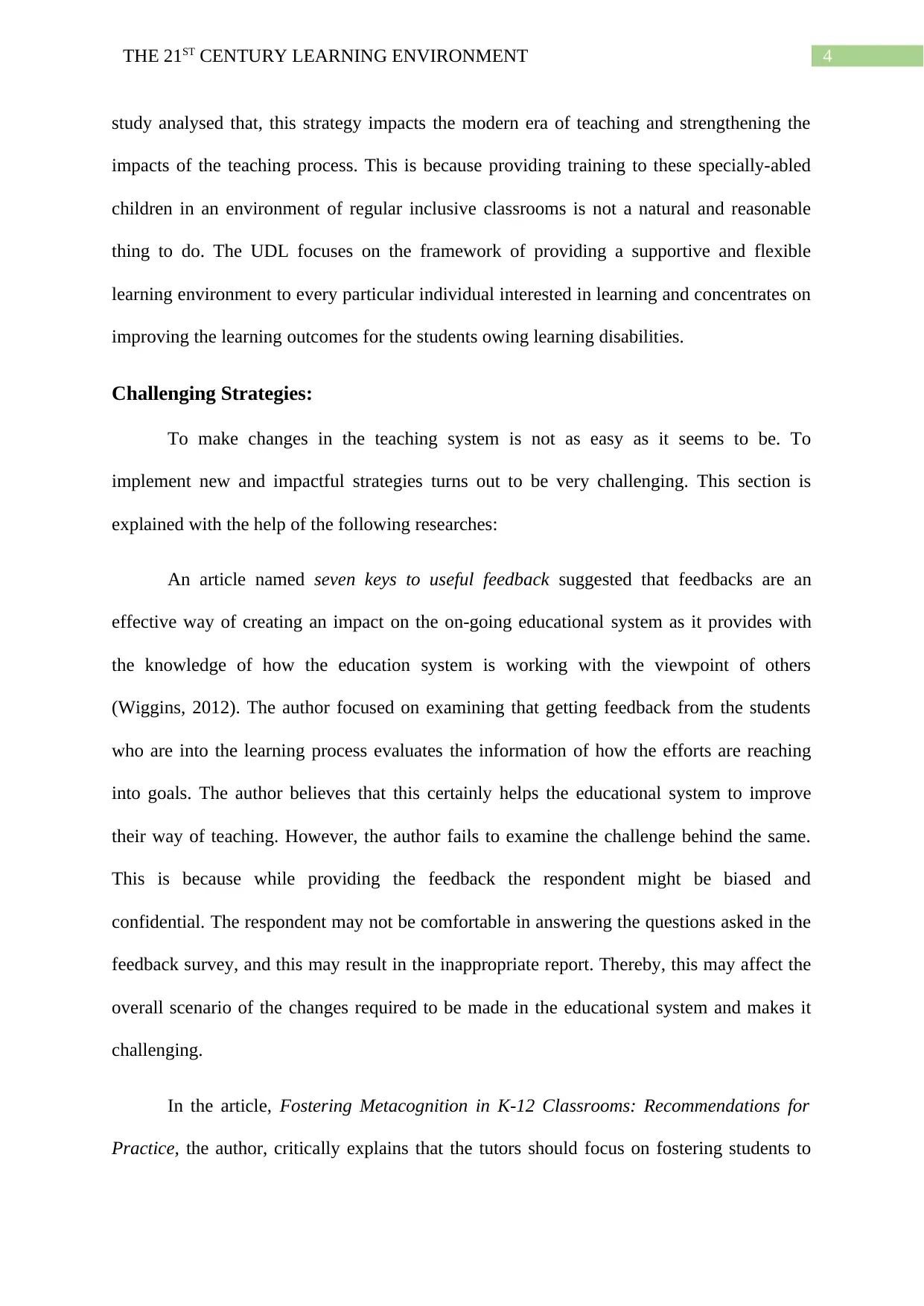
4THE 21ST CENTURY LEARNING ENVIRONMENT
study analysed that, this strategy impacts the modern era of teaching and strengthening the
impacts of the teaching process. This is because providing training to these specially-abled
children in an environment of regular inclusive classrooms is not a natural and reasonable
thing to do. The UDL focuses on the framework of providing a supportive and flexible
learning environment to every particular individual interested in learning and concentrates on
improving the learning outcomes for the students owing learning disabilities.
Challenging Strategies:
To make changes in the teaching system is not as easy as it seems to be. To
implement new and impactful strategies turns out to be very challenging. This section is
explained with the help of the following researches:
An article named seven keys to useful feedback suggested that feedbacks are an
effective way of creating an impact on the on-going educational system as it provides with
the knowledge of how the education system is working with the viewpoint of others
(Wiggins, 2012). The author focused on examining that getting feedback from the students
who are into the learning process evaluates the information of how the efforts are reaching
into goals. The author believes that this certainly helps the educational system to improve
their way of teaching. However, the author fails to examine the challenge behind the same.
This is because while providing the feedback the respondent might be biased and
confidential. The respondent may not be comfortable in answering the questions asked in the
feedback survey, and this may result in the inappropriate report. Thereby, this may affect the
overall scenario of the changes required to be made in the educational system and makes it
challenging.
In the article, Fostering Metacognition in K-12 Classrooms: Recommendations for
Practice, the author, critically explains that the tutors should focus on fostering students to
study analysed that, this strategy impacts the modern era of teaching and strengthening the
impacts of the teaching process. This is because providing training to these specially-abled
children in an environment of regular inclusive classrooms is not a natural and reasonable
thing to do. The UDL focuses on the framework of providing a supportive and flexible
learning environment to every particular individual interested in learning and concentrates on
improving the learning outcomes for the students owing learning disabilities.
Challenging Strategies:
To make changes in the teaching system is not as easy as it seems to be. To
implement new and impactful strategies turns out to be very challenging. This section is
explained with the help of the following researches:
An article named seven keys to useful feedback suggested that feedbacks are an
effective way of creating an impact on the on-going educational system as it provides with
the knowledge of how the education system is working with the viewpoint of others
(Wiggins, 2012). The author focused on examining that getting feedback from the students
who are into the learning process evaluates the information of how the efforts are reaching
into goals. The author believes that this certainly helps the educational system to improve
their way of teaching. However, the author fails to examine the challenge behind the same.
This is because while providing the feedback the respondent might be biased and
confidential. The respondent may not be comfortable in answering the questions asked in the
feedback survey, and this may result in the inappropriate report. Thereby, this may affect the
overall scenario of the changes required to be made in the educational system and makes it
challenging.
In the article, Fostering Metacognition in K-12 Classrooms: Recommendations for
Practice, the author, critically explains that the tutors should focus on fostering students to
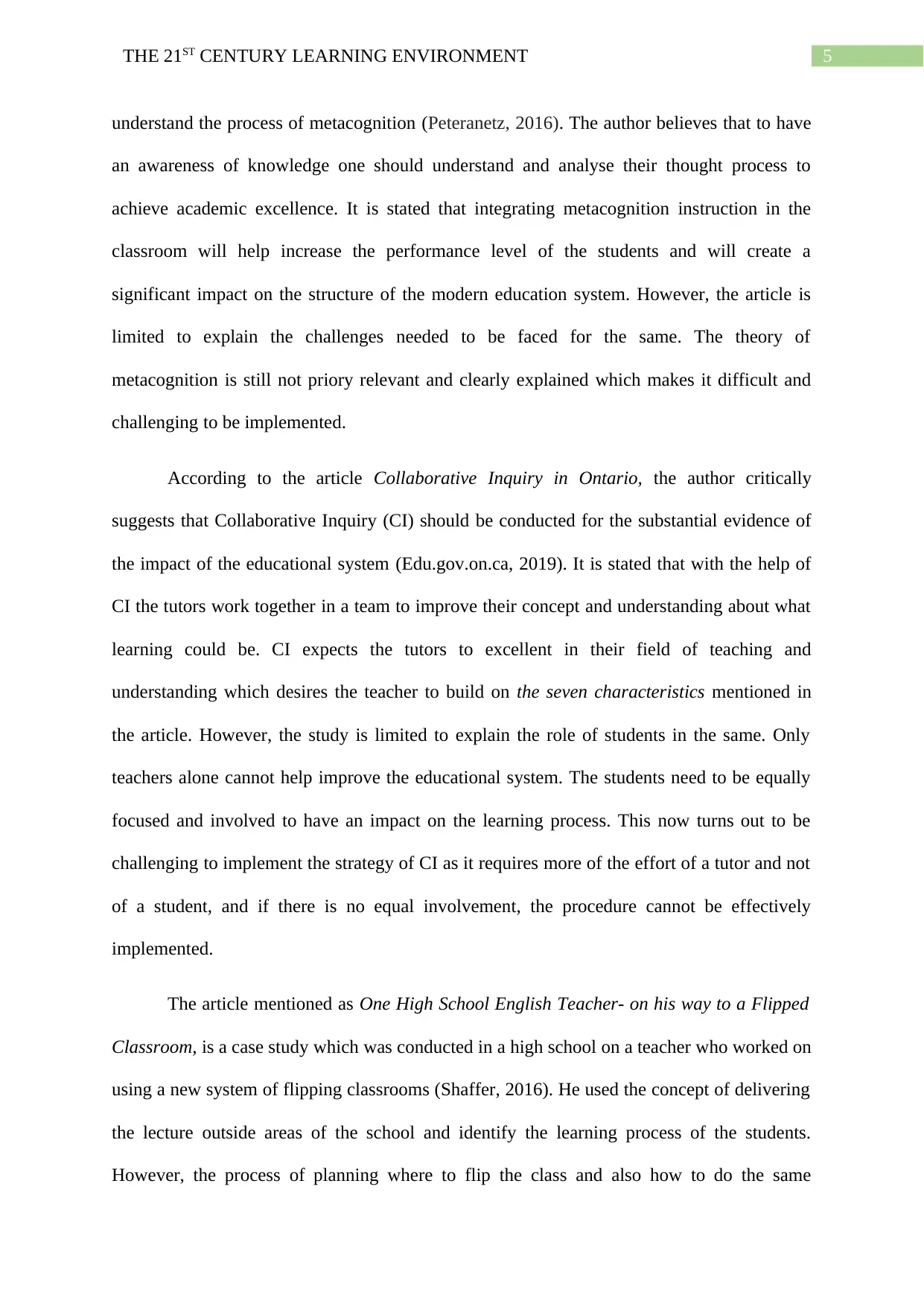
5THE 21ST CENTURY LEARNING ENVIRONMENT
understand the process of metacognition (Peteranetz, 2016). The author believes that to have
an awareness of knowledge one should understand and analyse their thought process to
achieve academic excellence. It is stated that integrating metacognition instruction in the
classroom will help increase the performance level of the students and will create a
significant impact on the structure of the modern education system. However, the article is
limited to explain the challenges needed to be faced for the same. The theory of
metacognition is still not priory relevant and clearly explained which makes it difficult and
challenging to be implemented.
According to the article Collaborative Inquiry in Ontario, the author critically
suggests that Collaborative Inquiry (CI) should be conducted for the substantial evidence of
the impact of the educational system (Edu.gov.on.ca, 2019). It is stated that with the help of
CI the tutors work together in a team to improve their concept and understanding about what
learning could be. CI expects the tutors to excellent in their field of teaching and
understanding which desires the teacher to build on the seven characteristics mentioned in
the article. However, the study is limited to explain the role of students in the same. Only
teachers alone cannot help improve the educational system. The students need to be equally
focused and involved to have an impact on the learning process. This now turns out to be
challenging to implement the strategy of CI as it requires more of the effort of a tutor and not
of a student, and if there is no equal involvement, the procedure cannot be effectively
implemented.
The article mentioned as One High School English Teacher- on his way to a Flipped
Classroom, is a case study which was conducted in a high school on a teacher who worked on
using a new system of flipping classrooms (Shaffer, 2016). He used the concept of delivering
the lecture outside areas of the school and identify the learning process of the students.
However, the process of planning where to flip the class and also how to do the same
understand the process of metacognition (Peteranetz, 2016). The author believes that to have
an awareness of knowledge one should understand and analyse their thought process to
achieve academic excellence. It is stated that integrating metacognition instruction in the
classroom will help increase the performance level of the students and will create a
significant impact on the structure of the modern education system. However, the article is
limited to explain the challenges needed to be faced for the same. The theory of
metacognition is still not priory relevant and clearly explained which makes it difficult and
challenging to be implemented.
According to the article Collaborative Inquiry in Ontario, the author critically
suggests that Collaborative Inquiry (CI) should be conducted for the substantial evidence of
the impact of the educational system (Edu.gov.on.ca, 2019). It is stated that with the help of
CI the tutors work together in a team to improve their concept and understanding about what
learning could be. CI expects the tutors to excellent in their field of teaching and
understanding which desires the teacher to build on the seven characteristics mentioned in
the article. However, the study is limited to explain the role of students in the same. Only
teachers alone cannot help improve the educational system. The students need to be equally
focused and involved to have an impact on the learning process. This now turns out to be
challenging to implement the strategy of CI as it requires more of the effort of a tutor and not
of a student, and if there is no equal involvement, the procedure cannot be effectively
implemented.
The article mentioned as One High School English Teacher- on his way to a Flipped
Classroom, is a case study which was conducted in a high school on a teacher who worked on
using a new system of flipping classrooms (Shaffer, 2016). He used the concept of delivering
the lecture outside areas of the school and identify the learning process of the students.
However, the process of planning where to flip the class and also how to do the same
⊘ This is a preview!⊘
Do you want full access?
Subscribe today to unlock all pages.

Trusted by 1+ million students worldwide
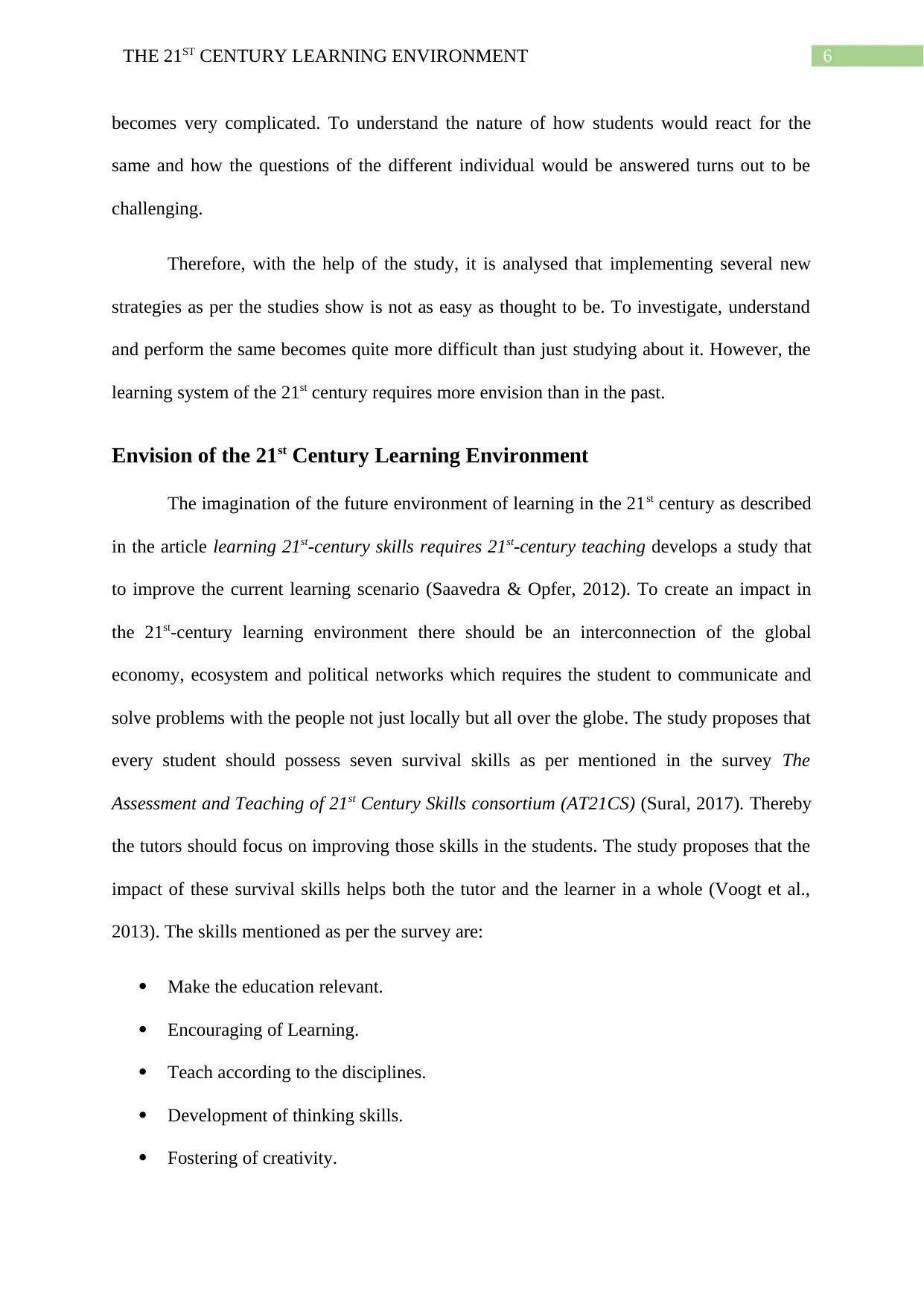
6THE 21ST CENTURY LEARNING ENVIRONMENT
becomes very complicated. To understand the nature of how students would react for the
same and how the questions of the different individual would be answered turns out to be
challenging.
Therefore, with the help of the study, it is analysed that implementing several new
strategies as per the studies show is not as easy as thought to be. To investigate, understand
and perform the same becomes quite more difficult than just studying about it. However, the
learning system of the 21st century requires more envision than in the past.
Envision of the 21st Century Learning Environment
The imagination of the future environment of learning in the 21st century as described
in the article learning 21st-century skills requires 21st-century teaching develops a study that
to improve the current learning scenario (Saavedra & Opfer, 2012). To create an impact in
the 21st-century learning environment there should be an interconnection of the global
economy, ecosystem and political networks which requires the student to communicate and
solve problems with the people not just locally but all over the globe. The study proposes that
every student should possess seven survival skills as per mentioned in the survey The
Assessment and Teaching of 21st Century Skills consortium (AT21CS) (Sural, 2017). Thereby
the tutors should focus on improving those skills in the students. The study proposes that the
impact of these survival skills helps both the tutor and the learner in a whole (Voogt et al.,
2013). The skills mentioned as per the survey are:
Make the education relevant.
Encouraging of Learning.
Teach according to the disciplines.
Development of thinking skills.
Fostering of creativity.
becomes very complicated. To understand the nature of how students would react for the
same and how the questions of the different individual would be answered turns out to be
challenging.
Therefore, with the help of the study, it is analysed that implementing several new
strategies as per the studies show is not as easy as thought to be. To investigate, understand
and perform the same becomes quite more difficult than just studying about it. However, the
learning system of the 21st century requires more envision than in the past.
Envision of the 21st Century Learning Environment
The imagination of the future environment of learning in the 21st century as described
in the article learning 21st-century skills requires 21st-century teaching develops a study that
to improve the current learning scenario (Saavedra & Opfer, 2012). To create an impact in
the 21st-century learning environment there should be an interconnection of the global
economy, ecosystem and political networks which requires the student to communicate and
solve problems with the people not just locally but all over the globe. The study proposes that
every student should possess seven survival skills as per mentioned in the survey The
Assessment and Teaching of 21st Century Skills consortium (AT21CS) (Sural, 2017). Thereby
the tutors should focus on improving those skills in the students. The study proposes that the
impact of these survival skills helps both the tutor and the learner in a whole (Voogt et al.,
2013). The skills mentioned as per the survey are:
Make the education relevant.
Encouraging of Learning.
Teach according to the disciplines.
Development of thinking skills.
Fostering of creativity.
Paraphrase This Document
Need a fresh take? Get an instant paraphrase of this document with our AI Paraphraser
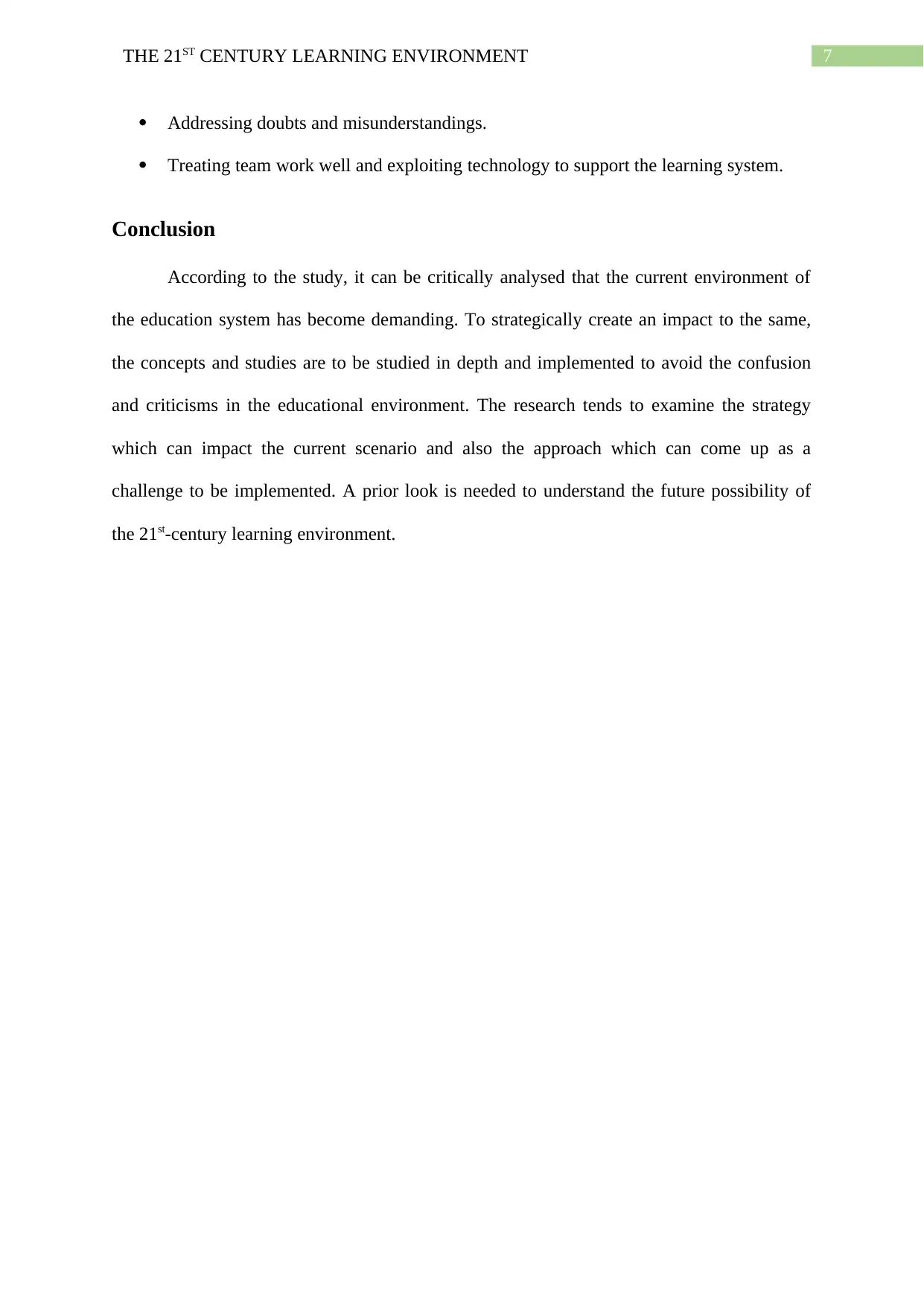
7THE 21ST CENTURY LEARNING ENVIRONMENT
Addressing doubts and misunderstandings.
Treating team work well and exploiting technology to support the learning system.
Conclusion
According to the study, it can be critically analysed that the current environment of
the education system has become demanding. To strategically create an impact to the same,
the concepts and studies are to be studied in depth and implemented to avoid the confusion
and criticisms in the educational environment. The research tends to examine the strategy
which can impact the current scenario and also the approach which can come up as a
challenge to be implemented. A prior look is needed to understand the future possibility of
the 21st-century learning environment.
Addressing doubts and misunderstandings.
Treating team work well and exploiting technology to support the learning system.
Conclusion
According to the study, it can be critically analysed that the current environment of
the education system has become demanding. To strategically create an impact to the same,
the concepts and studies are to be studied in depth and implemented to avoid the confusion
and criticisms in the educational environment. The research tends to examine the strategy
which can impact the current scenario and also the approach which can come up as a
challenge to be implemented. A prior look is needed to understand the future possibility of
the 21st-century learning environment.
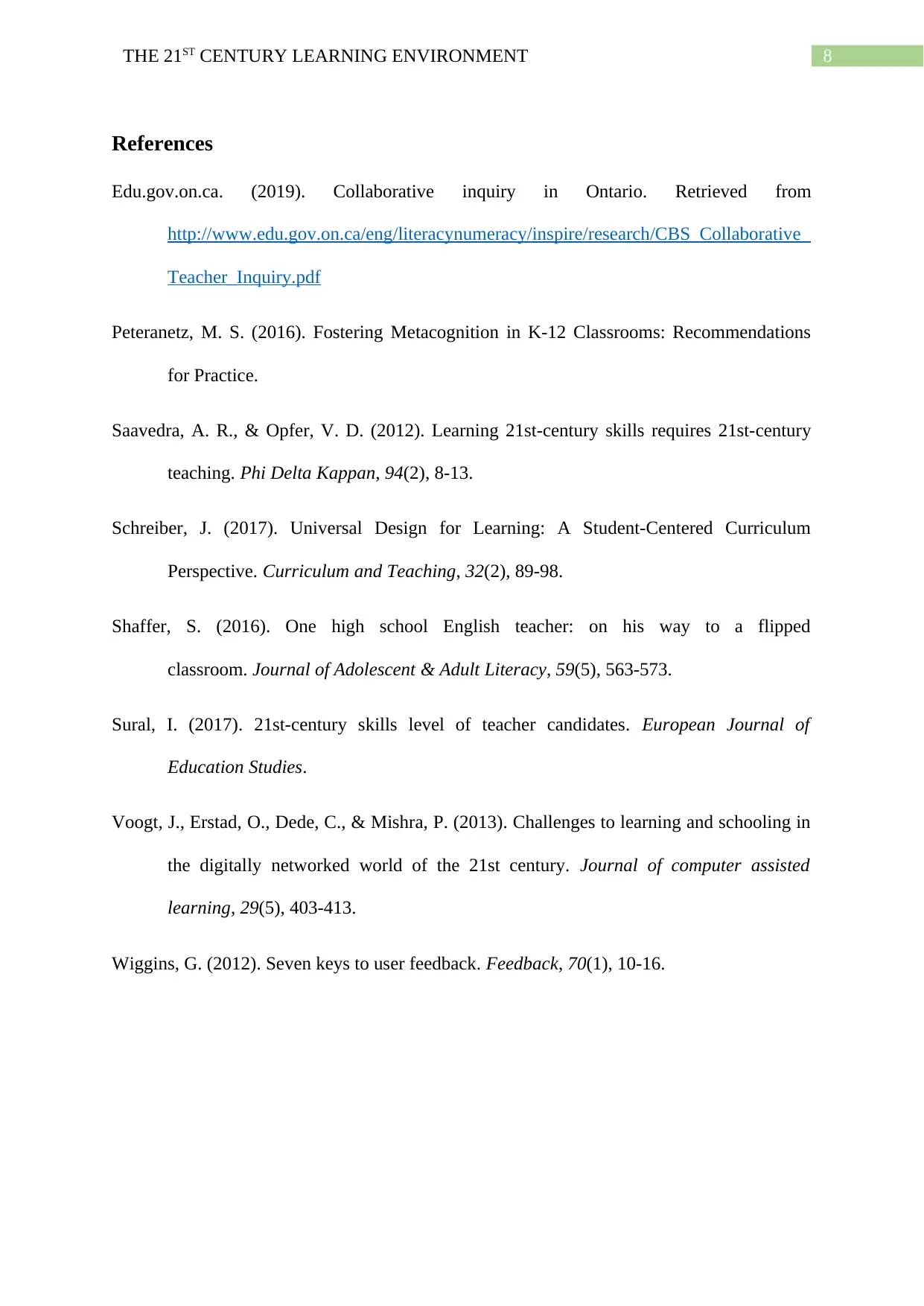
8THE 21ST CENTURY LEARNING ENVIRONMENT
References
Edu.gov.on.ca. (2019). Collaborative inquiry in Ontario. Retrieved from
http://www.edu.gov.on.ca/eng/literacynumeracy/inspire/research/CBS_Collaborative_
Teacher_Inquiry.pdf
Peteranetz, M. S. (2016). Fostering Metacognition in K-12 Classrooms: Recommendations
for Practice.
Saavedra, A. R., & Opfer, V. D. (2012). Learning 21st-century skills requires 21st-century
teaching. Phi Delta Kappan, 94(2), 8-13.
Schreiber, J. (2017). Universal Design for Learning: A Student-Centered Curriculum
Perspective. Curriculum and Teaching, 32(2), 89-98.
Shaffer, S. (2016). One high school English teacher: on his way to a flipped
classroom. Journal of Adolescent & Adult Literacy, 59(5), 563-573.
Sural, I. (2017). 21st-century skills level of teacher candidates. European Journal of
Education Studies.
Voogt, J., Erstad, O., Dede, C., & Mishra, P. (2013). Challenges to learning and schooling in
the digitally networked world of the 21st century. Journal of computer assisted
learning, 29(5), 403-413.
Wiggins, G. (2012). Seven keys to user feedback. Feedback, 70(1), 10-16.
References
Edu.gov.on.ca. (2019). Collaborative inquiry in Ontario. Retrieved from
http://www.edu.gov.on.ca/eng/literacynumeracy/inspire/research/CBS_Collaborative_
Teacher_Inquiry.pdf
Peteranetz, M. S. (2016). Fostering Metacognition in K-12 Classrooms: Recommendations
for Practice.
Saavedra, A. R., & Opfer, V. D. (2012). Learning 21st-century skills requires 21st-century
teaching. Phi Delta Kappan, 94(2), 8-13.
Schreiber, J. (2017). Universal Design for Learning: A Student-Centered Curriculum
Perspective. Curriculum and Teaching, 32(2), 89-98.
Shaffer, S. (2016). One high school English teacher: on his way to a flipped
classroom. Journal of Adolescent & Adult Literacy, 59(5), 563-573.
Sural, I. (2017). 21st-century skills level of teacher candidates. European Journal of
Education Studies.
Voogt, J., Erstad, O., Dede, C., & Mishra, P. (2013). Challenges to learning and schooling in
the digitally networked world of the 21st century. Journal of computer assisted
learning, 29(5), 403-413.
Wiggins, G. (2012). Seven keys to user feedback. Feedback, 70(1), 10-16.
⊘ This is a preview!⊘
Do you want full access?
Subscribe today to unlock all pages.

Trusted by 1+ million students worldwide
1 out of 9
Related Documents
Your All-in-One AI-Powered Toolkit for Academic Success.
+13062052269
info@desklib.com
Available 24*7 on WhatsApp / Email
![[object Object]](/_next/static/media/star-bottom.7253800d.svg)
Unlock your academic potential
Copyright © 2020–2025 A2Z Services. All Rights Reserved. Developed and managed by ZUCOL.




